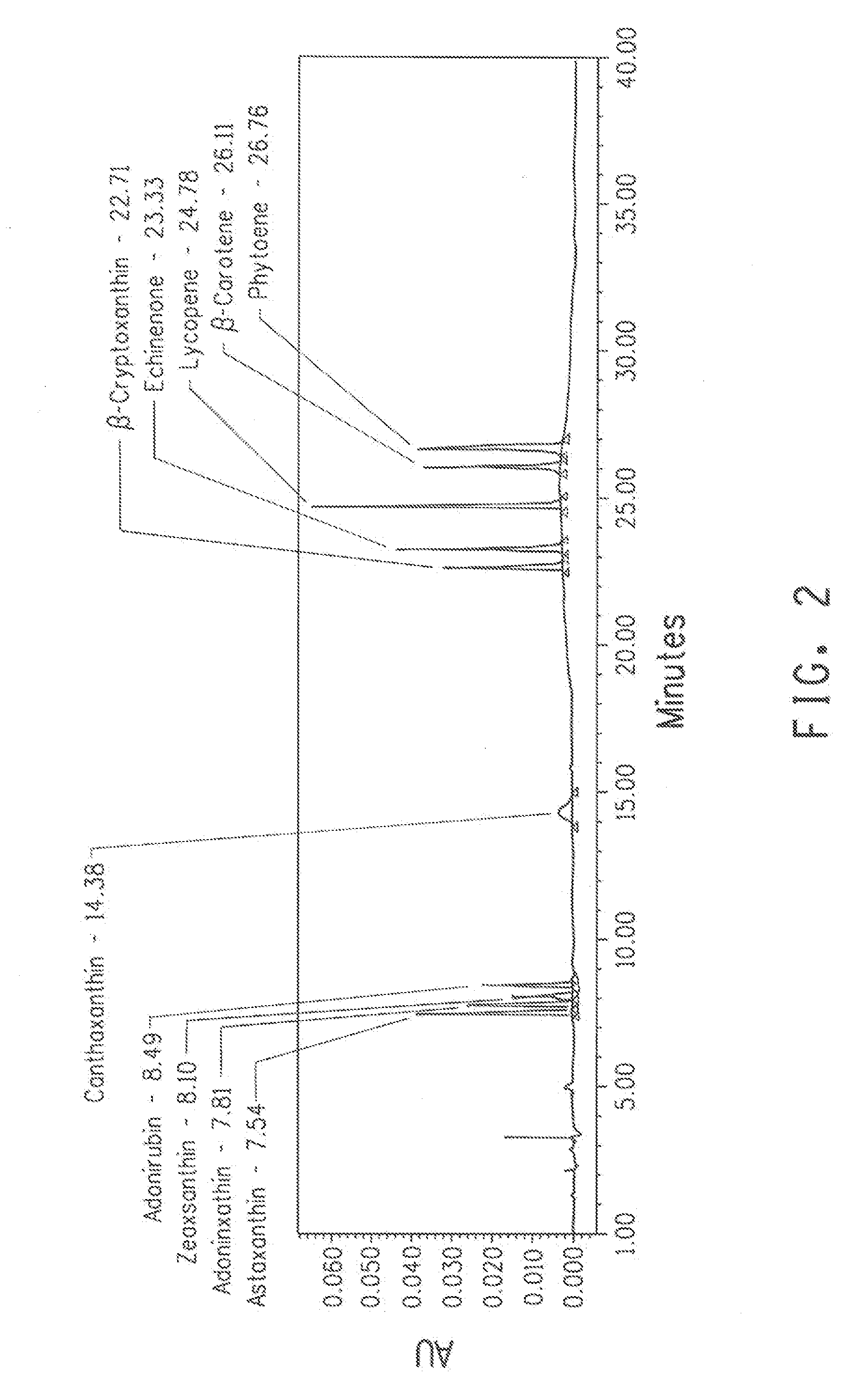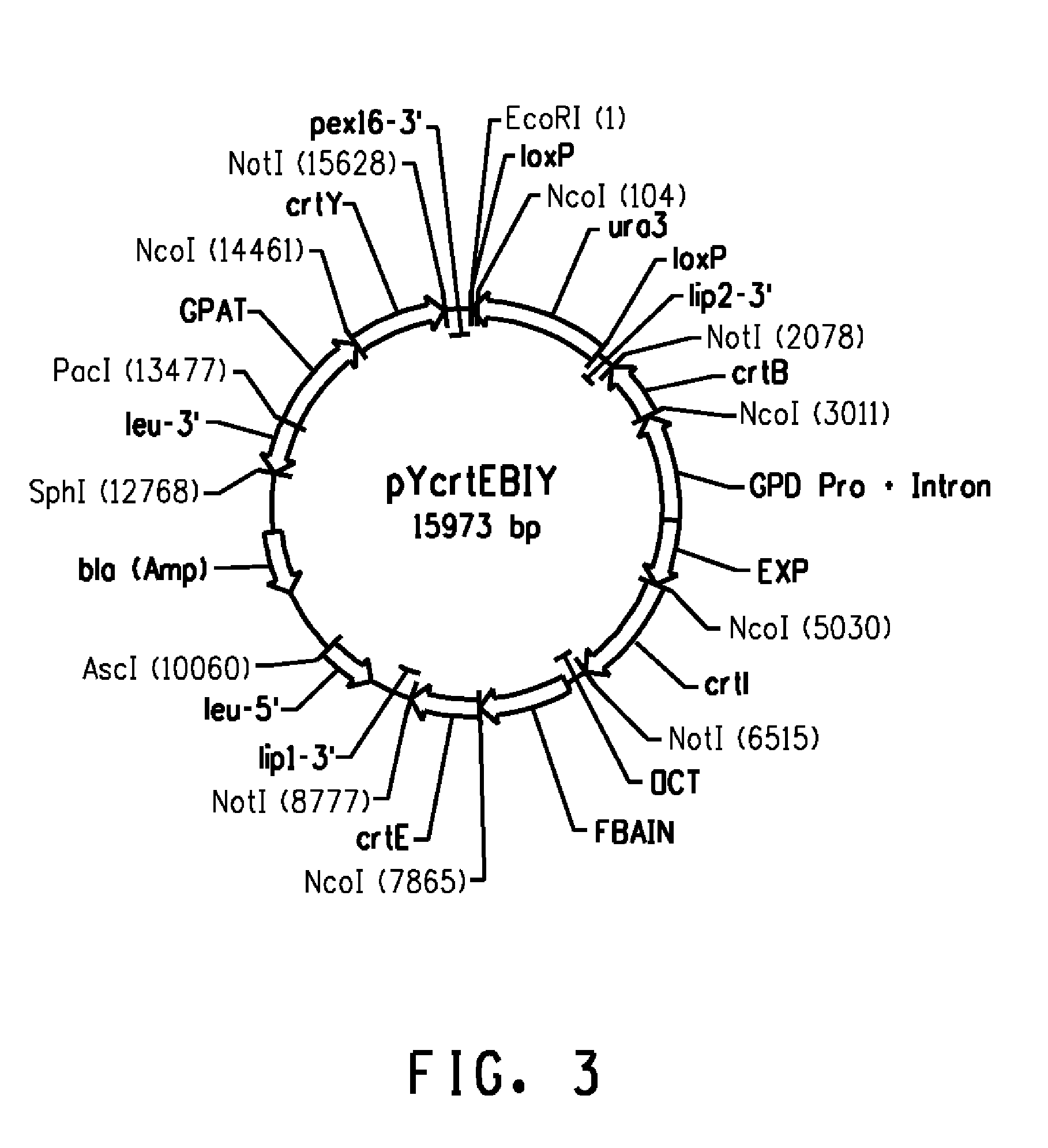Astaxanthin production using a recombinant microbial host cell
a technology of microbial host cells and microbial spores, which is applied in the field of biotechnology, can solve the problems of high associated cost, low productivity of carotenoid synthesis in these plants, and high cost of utilizing synthetically produced pigments
- Summary
- Abstract
- Description
- Claims
- Application Information
AI Technical Summary
Benefits of technology
Problems solved by technology
Method used
Image
Examples
example 1
Construction of Genetic Cassette for β-Carotene Production in Yarrowia Lipolytica
[0124]Production of β-carotene requires the expression of four genes; namely crtE, crtB, crtI and crtY (Table 2) which convert farnesyl diphosphate (FPP) to β-carotene (BC) through the formation of geranylgeranylpyrophosphate (GGPP), phytoene and lycopene, respectively in Yarrowia lipolytica (FIG. 1). The genes were selected from Enterobacteriaceae bacterium DC413 (U.S. Patent Application Publication No. 2012-0142082 A1) and codon-optimized for maximal expression in Yarrowia lipolytica (see U.S. Pat. No. 7,125,672 to Picataggio et al.).
TABLE 2Enzymes responsible for the conversion of farnesyl diphosphate(FPP) to β-carotene.Conversion stepEnzymeGeneFPP to GGPPGGPP synthasecrtEGGPP to PhytoenePhytoene synthasecrtBPhytoene to LycopenePhytoene desaturasecrtILycopene to β-CaroteneLycopene cyclasecrtY
[0125]Plasmid pZKLeuN-6EP (SEQ ID NO: 1; see U.S. Patent Application Publication No. 2012-0142082A1) based in...
example 2
Construction of Yarrowia Lipolytica Strains for the Production β-Carotene
[0126]Plasmid pYcrtEBIY (SEQ ID NO: 4) was digested with SphI / AscI and the 13.2 kb crtE-crtB-crtI-URA3-crtY fragment was gel purified. This fragment contained genes for the conversion of FPP until β-carotene. This fragment was used to transform Y. lipolytica Y2224 host and selected on minimal media plate without uracil. (Yarrowia lipolytica Y2224 is a URA3− derivative of Yarrowia lipolytica ATCC® 20362™; available from the American Type Culture Collection, Manassas, Va.). About 200 yellow color colonies were screened and about 30 colonies were selected for HPLC analysis. The strains produced β-carotene with the accumulation of phytoene and lycopene as intermediates (Table 5). Y. lipolytica strain BC9A was chosen for further analysis.
TABLE 5β-Carotene producing Y. lipolytica strain performance.PhytoeneLycopeneβ-CaroteneStrain(ppm)(ppm)(ppm)BC 6449552BC 1A248229BC 2A195237BC 3A216540BC 4A348452BC 5A63415BC 6A2053...
example 3
HPLC Method Development for Analysis of Carotenoids
[0127]The HPLC method was developed for the separation of astaxanthin and its intermediates based upon the published report (Cunningham Jr. F and Gantt E, The Plant Journal, 2005, 41: 478-492). Standard compounds were procured from CaroteNature GmbH (Ostermundigen, Switzerland). All the peaks were confirmed by taking mass fragmentation pattern. The HPLC conditions are mentioned in Table 6 and Table 7.
TABLE 6HPLC column and mobile phase.ColumnSUNFIRE ™ C18 250 mm × 4.6 mm: 5 um (WatersCorporation, Milford Massachusetts)Mobile Phase AAcetonitrile:Water:Triethylamine (90:10:0.1 V / V)Mobile Phase B100% Ethyl acetateColumn Temp25° C.Sample Temp4° C.Wavelength210 nm-700 nmFlow1.0 mL / min
TABLE 7Gradiant of the mobile phase in HPLC.Time (min)% A% B0.01901015752518.0505023.0208030.0752540.09010
Astaxanthin and nine intermediates of the pathway were well separated in a single HPLC run (Table 8, FIG. 2).
TABLE 8Retention time of astaxanthin and re...
PUM
| Property | Measurement | Unit |
|---|---|---|
| pH | aaaaa | aaaaa |
| pH | aaaaa | aaaaa |
| pH | aaaaa | aaaaa |
Abstract
Description
Claims
Application Information
 Login to View More
Login to View More - R&D
- Intellectual Property
- Life Sciences
- Materials
- Tech Scout
- Unparalleled Data Quality
- Higher Quality Content
- 60% Fewer Hallucinations
Browse by: Latest US Patents, China's latest patents, Technical Efficacy Thesaurus, Application Domain, Technology Topic, Popular Technical Reports.
© 2025 PatSnap. All rights reserved.Legal|Privacy policy|Modern Slavery Act Transparency Statement|Sitemap|About US| Contact US: help@patsnap.com



